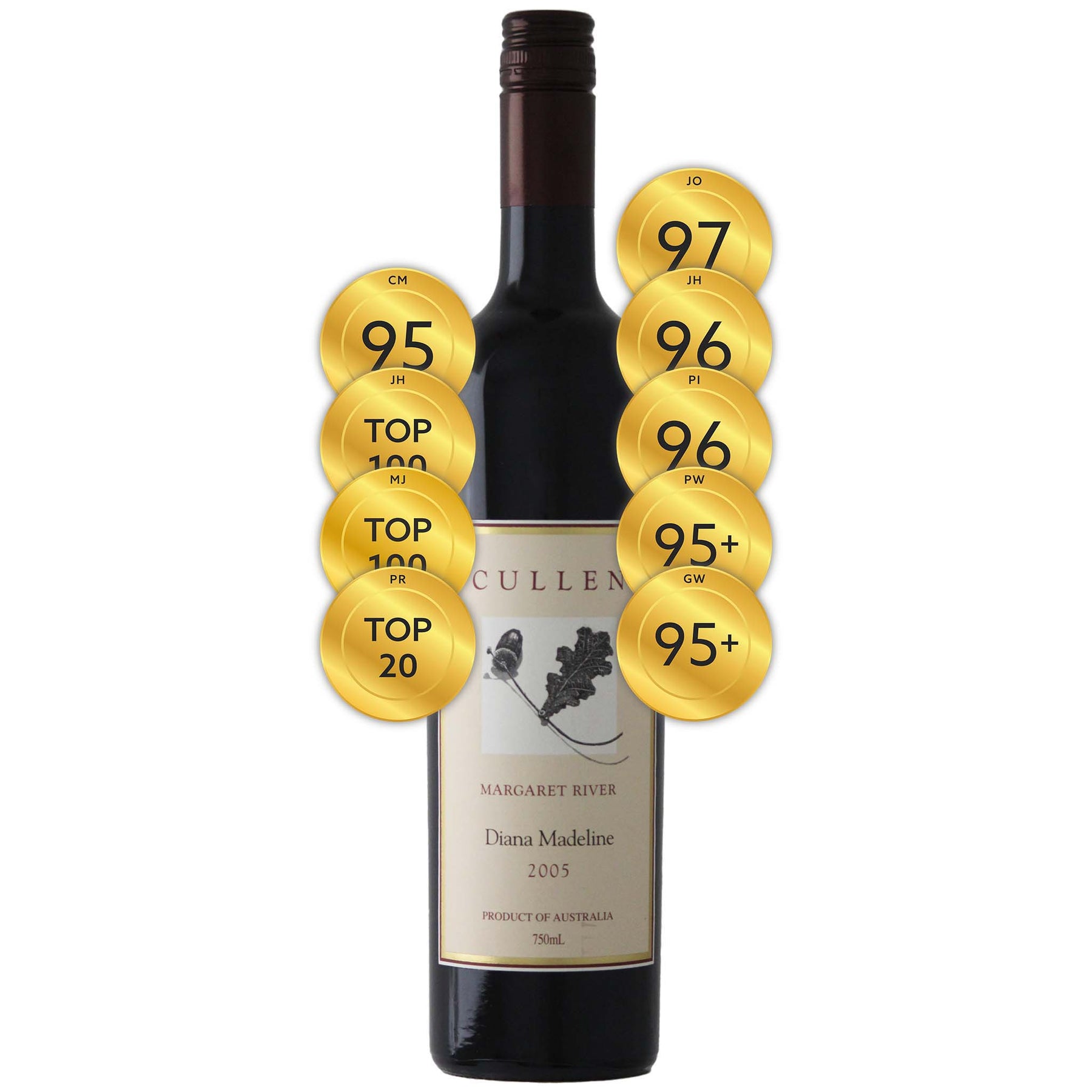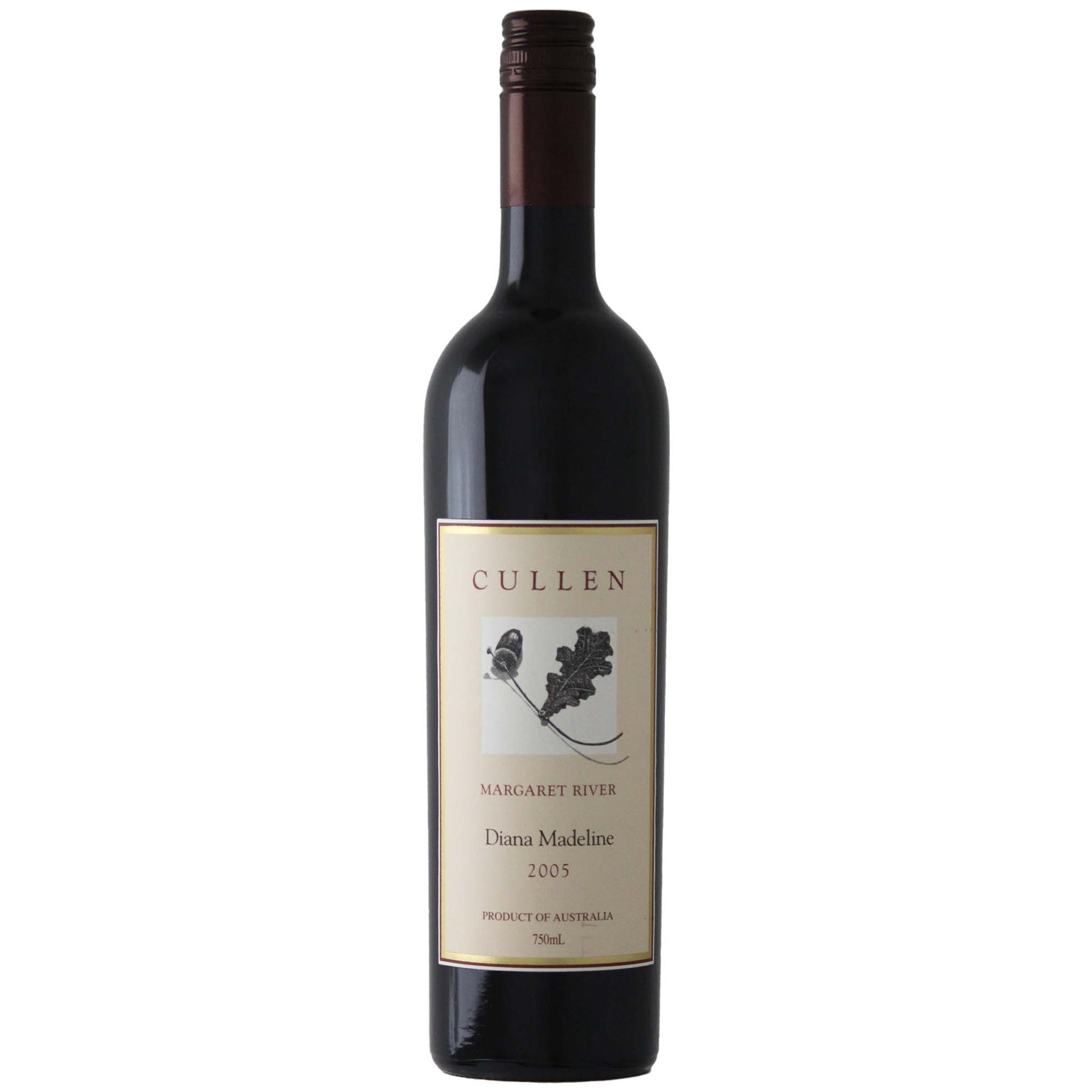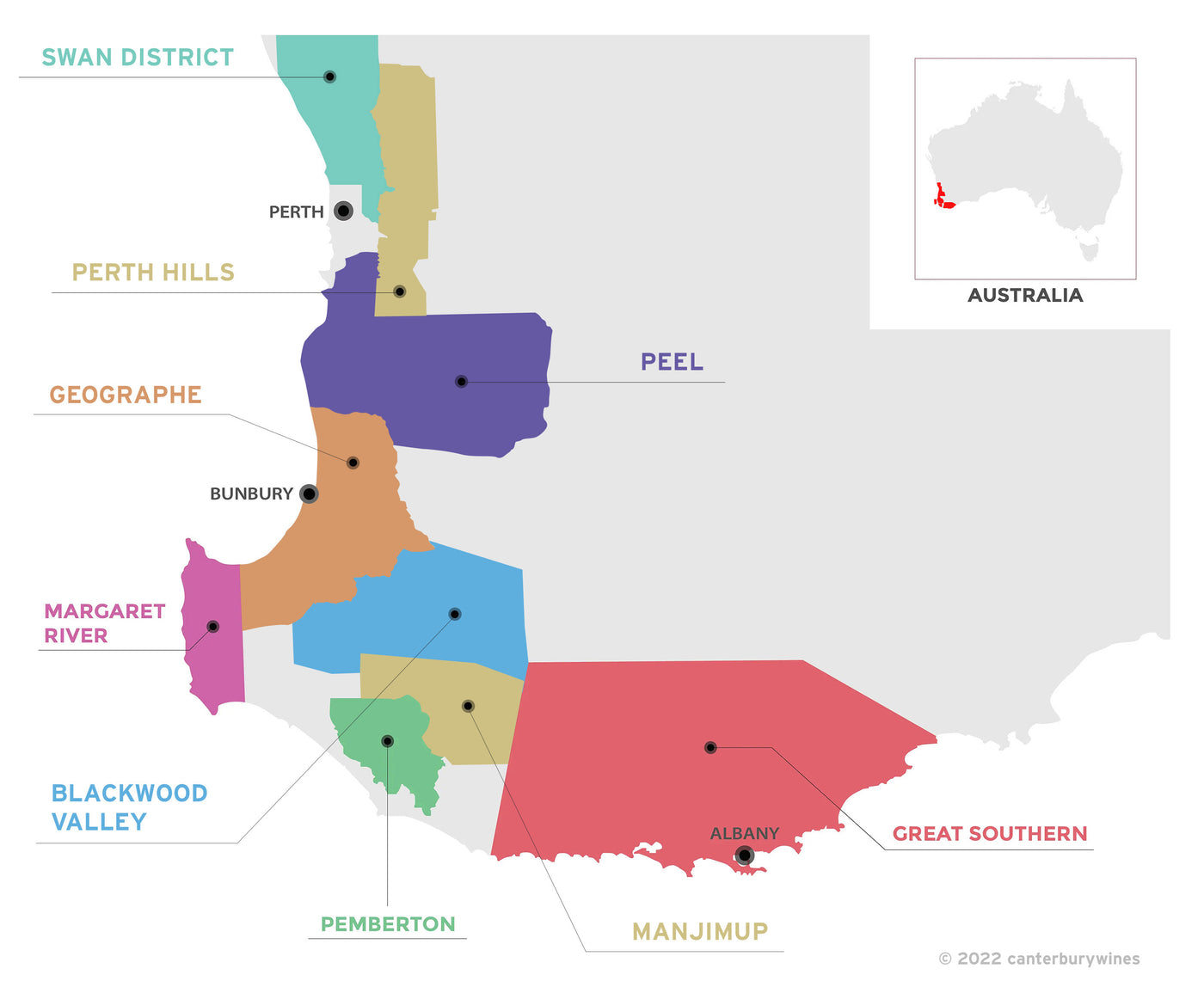

Cullen Diana Madeline 2005
Style: Red Wine
Closure: Screwcap
Cullen Diana Madeline 2005
Warehouse
34 Redland Drive
Vermont VIC 3133
Australia
Critic Score: 97 and 19/20
Alcohol: 14.0%
Size: 750 ml
Drink by: 2035
James Halliday Top 100 Wines of 2007
Philip Rich Top 20 Wines of 2007
Matthew Jukes Top 100 Wines of 2008
Peter Forrestal Top 100 Drops
Cullen is an iconic Margaret River winery and the Diana Madeline is their flagship red wine. It is famed for its quality and consistency, is sought after by collectors world-wide and is a worthy regional benchmark. It is a classic Cabernet Sauvignon dominant Bordeaux blend grown on an exemplary vineyard. By 2005 the Cullen vineyard was certified both Organic and Biodynamic.
"The Margaret River Cabernet pair in this year's Top 100 may perhaps be a little predictable, but they won their places fair and square by simply tasting the others clean off the page. The 2005 Diana Madeline is a huge wine with firm tannins and a long life ahead of it. It reminded me of some 2005 Paulliacs, which are typified by their intricate marquetry overlaying a muscle-bound core of unyielding cassis fruit." Matthew Jukes
"This is a great wine and one of the very finest Bordeaux blends ever produced at Cullens. It was made using all of the five red grape varieties of Bordeaux, with Cabernet Sauvignon comprising three quarters of the blend. Merlot was the next most important contributor with 16%, followed by Malbec (5%), Cabernet Franc (3%) and Petit Verdot (1%). The wine has benefited from having been matured for 19 months in French barriques, of which 70% were new.
Magnificent deep inky red with strong purple meiniscus. Youthful, concentrated and intense pot-pourri of dark berry fruits on the nose. Powerful and sumptuous, with the wonderful black cherry flavours in the middle palate being backed by fine-grained tannins and leading into a rewardingly long and lingering finish. Cellaring: At least 15 years." Vanya Cullen
Expert reviews
"Wow! Elegance meets structure, meets sophistication. Scented with violets and sweet cedary new oak, its perfume of small red and black berries, dark cherries reveals complex earthy undertones with a hint of gravel. Full to medium in body but steeped with vibrant flavours of dark berries, cherries, its seductively smooth but opulent palate revels in its marriage of fruit, oak and firm, Graves-like chalky tannin. Exceptionally long and perfectly harmonious, it's both polished and powerful, with a brilliant future. Drink 2025-2035." Jeremy Oliver - 97 points
"My top WA wine of the year. It's opulent, succulent, well structured, fleshy and velvety, with fine, slinky tannins." Peter Forrestal, Top 100 Drops – 19.0/20 points
"Vanya Cullen only knows how to make great wine, here juggling cabernet sauvignon (75%), merlot, malbec, cabernet franc and petit verdot. In archetypal Cullen style, it has a backbone of ripe but persistent tannins to the array of black fruit flavours, which have the density and intensity to easily carry the wine through to its very long plateau of maturity. Drink 2010-2030." James Halliday, The Weekend Australian - 96 points and Top 100 Wines of 2007
"This beautifully crafted, concentrated and medium-to-full-bodied wine is the latest in a long list of great Margaret River cabernets from Vanya Cullen over the years. Ultra perfumed with violets, cedar, earth, blackcurrants, dark cherries and a hint of complexing bell pepper, the palate is still backward – with finely grained and very persistent tannins rounding out a wine which will require at least five years to soften. Should be drinking well 15 to 20 years from now." Philip Rich, Australian Financial Review - Top 20 Wines of 2007
"The Margaret River Cabernet pair in this years 100 may perhaps be a little predictable, but they won their places fair and square by simply tasting the others clean off the page. The 2005 Diana Madeline is a huge wine with firm tannins and a long life ahead of it. It reminded me of some 2005 Paulliacs, which are typified by their intricate marquetry overlaying a muscle-bound core of unyielding cassis fruit." Matthew Jukes – Top 100 Australian Wines of 2008
"This is a Cabernet Sauvignon, Merlot, Malbec, Cabernet Franc and Petit Verdot red blend of epic proportions from respected winemaker Vanya Cullen of this leading Australian wine producer. Nineteen months in French oak has resulted in a wine that is drinking beautifully right now but with the restraint and power that augurs for a very long and prosperous future. Black fruits, hints of vegemite, currants, spicy plums and roasted meats are only some of the contributors to a complex array of characters in the aroma profile of this wine. Revealed in layer upon layer, complexity abounds. Seamless in mouthfeel, balanced and just beautiful flavours. Good coffee mocha oak, ultra fine tannins, a touch of silkiness – indeed a very classy and elegantly structured red with lingering liquorice and dark chocolate on the finish. Try this Wagyu beef. Drink to 2027 plus." Paul Ippolito - 96 points
"Left-wing wine: I collapse, boneless, here. The lively berries, the naughty spring meadowflower freshness, the wicked lollyshop musk and bright violets and lavender that you never see in 100% cab are here, thanks to the mad persistence of Vanya Cullen's hatred of chemicals, full bore plunge to perfect guzzling blended squish, and absolute pursuit of biodynamic hooley dooley holiness. Cab sav, franc, merlot, malbec and verdot be perfumed here, sans sprays and poisons. It friggin rocks. Close table or bedside supping now; real mushy wedding shit in a decade or so." Philip White, The Independent Weekly – 95++ points
"This year a blend of 75% cabernet, 16% merlot, 5% malbec, 3% cabernet franc and 1% petit verdot with the grapes being grown according to Bio-Dynamic principles. In order to get into the spirit of things I swirled the wine anti-clockwise while suspending a crystal over the top before tasting. Actually, I think there really is something in this Bio-Dynamic wines lark, and to paraphrase the great Reeves & Mortimer – 'I don't know how it works…but it does!'.
Aromas of violet, sweet cherry, berry, bayleaf, a little beef stock and most attractive lead pencil oak with hints of asprin that some young screw-capped wines show. On the palate full bodied but very reserved and controlled with cherry, berry, clove, bayleaf and cedar flavours. Masses of mouthcoating firm tannins and noticeable cheek puckering acidity lay the foundations for decades of development. There is little pleasure to be found in this wine at present so don't even think about thinking about opening one for at least ten years. It's great but wait. Drink: 2018 - 2030+." Gary Walsh, The Wine Front - 95+ points
"This is a boomer. It is the best since 2001. It is strong, pure, muscular, wrapped in big arms of tannin and statuesque in its bright, clean, dark fruit profile. There's a sense of the tall, dark and handsome about this. It presents as a straight, perfumed, controlled burst of plums, blackcurrant, cedar, cigarbox, musk, chocolate and cloves, the merest tip of eucalypt giving it lift and life. This is a 20-year, long-haul wine. Don't touch it for a long time. Blend this year is cabernet sauvignon 75%, merlot 16%, malbec 5%, cabernet franc 3% and petit verdot 1%. Drink: 2018-2027+." Campbell Mattinson, The Wine Front - 95 points
Awards
James Halliday Top 100 Wines of 2007
Philip Rich Top 20 Wines of 2007
Matthew Jukes Top 100 Wines of 2008
Peter Forrestal Top 100 Drops
Organic/biodynamic

The combination of firstly organic, and subsequently biodynamic viticulture at Cullen Wines provides the opportunity for the land to exist at its full potential, thereby nurturing vines to produce their best and most individual grapes. Vanya Cullen has pushed the limits of biodynamic practices in every facet of the business and the yield of the estate vineyards has soared. All Cullen Wines are grown on a certified Biodynamic, Carbon Neutral and naturally powered estate.
Organic Viticulture
Since 1971 when the Cullen Vineyard was planted, chemical intervention was minimal and the family's concern for the environment paramount. In 1998 the change to total organic viticulture was made. Organics is about soil health and Diana and Vanya went intuitively towards healing the soil by putting back what had been taken out. Organic farming promotes biological activity, which converts plant and animal residue into stable humus. This in turn increases the soil's ability to retain moisture and provide a reserve of nutrients. The Cullen vineyards were certified A Grade Organic in 2003.
Biodynamic Viticulture
In 2003, whilst attending a Biodynamic Conference, Vanya Cullen decided that Biodynamics would add further to the holistic and natural approach to both vineyard and winemaking. Biodynamics builds on organic farming to make all organic processes work more efficiently and effectively.
Biodynamic viticulture is a philosophy combining the maintenance of sustainable soil fertility and the recognition of the link between plant growth and the rhythms of the cosmos. Moon rhythms strongly influence life on earth life. As tides rise and fall in a pulsing rhythm, so does the sap of plants and all other liquids including those within the earth's mantle. Viticultural practices are conducted according to these moon rhythms. The position of the moon in relation to the planets is critical in determining the optimal time to plant.
In addition, the difference between organic and biodynamic is the use of biodynamic preparations 500 and 501, with 502-508 also being used. Preparation 500 is cow horns filled with cow manure which helps the soil develop humus and attracts earthworms and micro organisms. Preparation 501 is cow horns filled with quartz crystals which aids photosynthesis and the uptake of minerals in the soil.
In 2004 the Cullen vineyards were certified A Grade Biodynamic.
About the winery

In 1948, Dr Kevin John Cullen and his wife Diana Madeline Cullen purchased their property in Wilyabrup, which is in the heart of Margaret River. In early 1965 they started considering other uses for their sheep and cattle farm. They decided to plant lupins, so invited Dr John Gladstones (who had studied lupins in his post-graduate research) to visit their property. Dr Gladstones had also put considerable work and research into the suitability of growing vines in southwestern Australia and, according to Diana, upon seeing their land said "Oh, you're mad growing cattle and sheep, why don't you grow grapes?"
Dr Gladstones described Wilyabrup as being the sweet spot of the Margaret River region, most favourable for growing Cabernet Sauvignon. In 1966 he published his now-famous report which compared the climate and soils of Margaret River to that of Bordeaux. Many regard him as the founder of the Margaret River wine region.
In 1971 Kevin and Diana Cullen made the decision to plant 18 acres of vines on the land, including their first Cabernet Sauvignon vines. Further plantings were made over the subsequent decades. The mature 28-hectare dry grown vineyard still operates today and the grapes for all the Cullen wines are sourced from here and the adjacent Mangan Vineyard which was planted in 1995.
While Kevin Cullen worked as a doctor to support the business, Diana Cullen supervised and managed the winery and became Chief Winemaker in 1981. Diana made history in 1982 by being the first woman to win a trophy at the Perth Royal Show. Kevin passed away in 1994 and Diana in 2003, and the Cullen flagship wines are now named in their honour; the Kevin John Chardonnay and Diana Madeline Cabernet Sauvignon Merlot. Both Kevin and Diana have been awarded life membership with the Margaret River Wine Industry Association, and in 2003 the WA Wine Industry Association introduced the annual Diana Madeline Cullen Award for Outstanding Contribution by an Individual to the WA Wine Industry in her honour.
In 1983 Diana was joined by daughter Vanya Cullen, who took over the reign as Chief Winemaker in 1989 and was also appointed Managing Director in 1999. With Vanya at the helm, the quality of the wine is paramount and every step taken in the vineyard and in the winemaking is geared to that aim. The quality of Cullen Wines comes in the main from the vineyard - the wines can only be as good as the grapes. To realise the full potential of the vineyard, Vanya has embraced organic and biodynamic viticultural practices and the vineyards were certified A Grade Organic in 2003 and A Grade Biodynamic in 2004.
The process of making the wine involves handling the fruit as little and as gently as possible. Practices such as hand harvesting, minimal fruit transport, sorting of the fruit before crushing, minimal wine movement, minimal fining for the whites, no fining for the reds and minimal filtration are employed. The wines mostly make themselves, with little or no intervention; which means the use of indigenous yeast, no additions of any kind and minimal oak use and fining.
Vanya Cullen received the "Australian Winemaker of the Year" award from Gourmet Traveller Wine magazine in 2000 and was voted "Woman of the Year" by UK based wine magazine The Drinks Business in 2008, becoming the first Australian to receive the award. Vanya was also awarded Halliday Wine Companion's winemaker of the year in 2020.
Cullen became the first vineyard and winery in Australia to be certified carbon positive, starting the process in 2006. Vanya Cullen is also on the board of the "Days of Change" program, which aims to help Western Australian people and businesses live and operate in a more sustainable way.
2021 marked a half-century for the brand and with it a celebration of the Cullen Wines legacy. "This year we celebrate 50 years of Cullen Wines – 50 years of sustainable wine growing preceded by 65,000 years of Wadandi sustainable land care," says Vanya. "Over that time we've been supported by generous people with a wonderful spirit of camaraderie and warmth of spirit, and we are so grateful."


Western Australia
Western Australia is home to more than 400 wineries across nine vast and extraordinary wine regions which are almost entirely concentrated in the south-west and great southern land divisions of the State. The regions are Blackwood Valley, Geographe, Great Southern, Peel, Pemberton, Manjimup, Margaret River and Swan District.
The oldest region is the Swan Valley, the best known both nationally and internationally is Margaret River and the largest is Great Southern. The Great Southern region is further divided into the five subregions of Albany, Denmark, Frankland River, Mount Barker and Porongurup.
The history of wine production in Western Australia dates back to 1840 with the establishment of Sandalford in the Swan Valley region. The recognition of the fine wine possibilities started to be realised after the establishment of the Margaret River Region in 1967, which has become renowned for its high quality Chardonnay and Cabernet Sauvignon. The other regions produce a diverse range of regionally distinct wines, from stunning Rieslings and evocative Shiraz, to a range of unique Cabernet Sauvignon blends.



